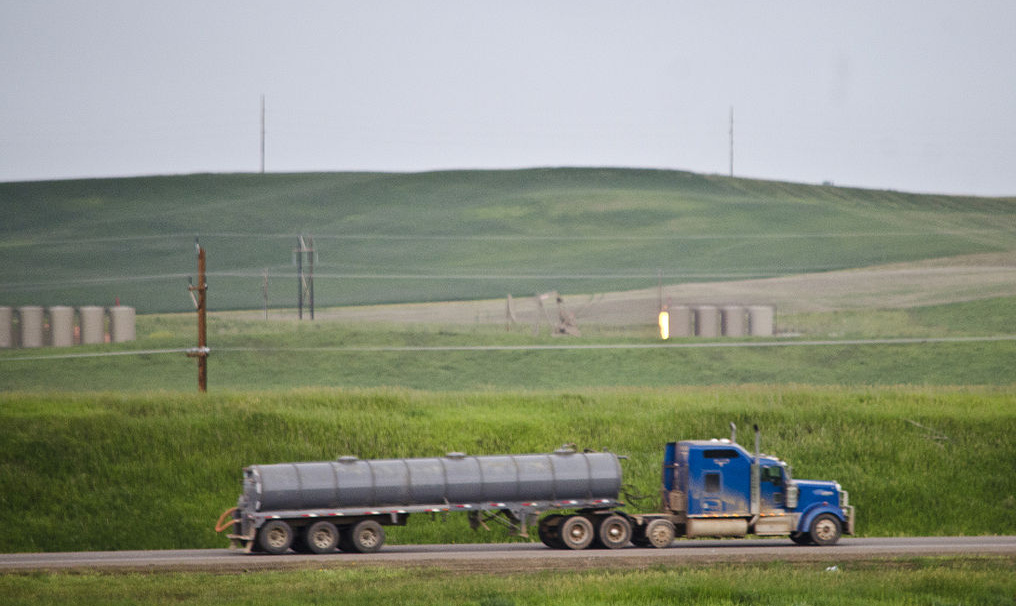
Oil production in the Permian oil fields has created its own set of problems. There’s more oil being produced than can be efficiently moved out of the area. That’s partly due to a lack of truck drivers, along with inadequate infrastructure to support them. It’s a two-way problem in which needed supplies can’t come in fast enough and pumped oil can’t get out efficiently.
Fixing that problem isn’t easy. Building new roads or adding pipelines will exacerbate the problem in the short term, because it will further strain the existing infrastructure. That’s a challenge because of the volatility of the price of oil and the length of time it takes to add billions of dollars in improvements to roads, pipelines, and potentially railways.
Nick Sciple and Dan Kline tackle the topic in this segment of Industry Focus .
Video was recorded on Oct. 18, 2018.
Nick Sciple: Let’s talk about how trucking is impacting the energy market. Over the past three years, we’ve seen United States oil output really coming to fresh new highs, production in the Permian has more than doubled. We’ve mentioned the Permian in the past on the show, for folks who haven’t listened. This is a large oil field in West Texas. It’s been in existence for a long period of time, but over the past several years was the rise of fracking. We were able to get access to oil there was not previously accessible there, which has really led to a huge boom in that area of that country.
Do you want to talk a little bit about how that’s affecting trucking?
Dn Kline: Yeah. It’s created its own set of problems. Just because you have the ability to pump all this oil doesn’t mean you have the infrastructure to get that oil to market. We’ve actually found that oil prices for oil pumped from the Permian have gone down. They have to supplement the fact that there’s an added cost of trucking. They don’t have adequate pipelines, they don’t have adequate trucking themselves to get the oil to where it needs to go. It’s going to take years. They’re actually building wells that they’re not using, that they’re not pumping from, in order to stake the claim on the oil, but they can’t get that to market; and if they do, they can’t do it efficiently. At the moment, yes, we have all this resource, but it’s actually creating more problems than it solves.
Sciple: Exactly, Dan. I think another thing we need to talk about, as well, is that it’s not just getting that oil out of the ground and bringing it to market, which is also a significant role for trucking, particularly with the lack of pipeline capacity in the Permian right now. But it’s getting those supplies needed to do the drilling to the wellhead. That may be fracking sand that you need to get to the wellhead. You have to bring water to help pump into the well. You have wastewater that may be needed to take away. All those sorts of things require a truck and a driver to bring them to the wellhead or to take them from the wellhead to market.
I talked about at the beginning how this is a little bit of a boom town situation. We’ve seen a mass of people coming into the Permian. There’s been a huge shortage of truck drivers and there’s several reasons behind that. First off, U.S. 285 is the large thoroughfare between Carlsbad, New Mexico and Pecos, Texas, which is really the heart of the Permian. Over that period of time, from 2008, when fracking really started getting out of the ground, until last year, traffic on that road has gone up 10X. You already have a shortage of drivers, but in addition to that, you have the infrastructure that those drivers use to transport goods from place to place really becoming strained. That’s not just in the Permian. This is a microcosm of this. Nationwide, we’ve had infrastructure problems. We saw it in the last presidential election. It was a huge issue. That’s a thing that’s affecting the Permian.
So, we have this infrastructure problem. How do you fix the problem? You invest in infrastructure, you build out the road. What does that do? Well, that means that you have to have workers on the road, which makes this problem even worse, because you already have too many people for not enough road, you’re doing work on it, it makes the congestion even worse. This is another thing to add in when we’re talking about trucking: according to the American Trucking Association, the trucking industry loses $50 billion a year sitting in traffic. That could be places like the Permian, with an artificially large number of people there. But it could just be in other places across the country where infrastructure is really dropping the ball.
Kline: This is one of those cases where you have to, at some point, accept the pain. I think we’ve all lived someplace where they announced, “We’re going to widen the highway,†and you think, “That’s great! I drive to work, there’ll be four lanes instead of three.†What you don’t think about is that for two years, there will be two lanes instead of three as they deal with this. That’s what has to happen in the Permian. Whether they build a new highway, whether they build rail capacity to get some of this stuff in, new pipelines, they’re going to have to do this. The problem is, when you’re forecasting something like oil prices, you don’t know, three years from now, what the impact of electric vehicles will be. The demand for oil could be dramatically different. We saw a lot of this in the most recent Texas oil bust in the 80s. People had built an economy based on oil at $80 a barrel or whatever the number was. When it dropped to $30, people lost their entire businesses. Things like sports teams collapsed in those areas because there simply wasn’t the income there used to be. That could happen if you make the decision to spend billions on building new roads.
Sciple:Â Right. This is just a microcosm for the limitations of infrastructure, as well as, when you put strains on areas, how trucking and things that seem like a background industry really come to the fore and limit the prospects for growth.
The Motley Fool has a disclosure policy .
The views and opinions expressed herein are the views and opinions of the author and do not necessarily reflect those of RigLynx or OutPut.
Image courtesy of creative commons under license 2.0Â : Author Tim Evanson



